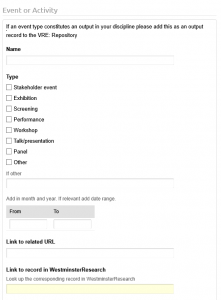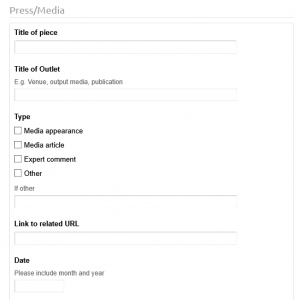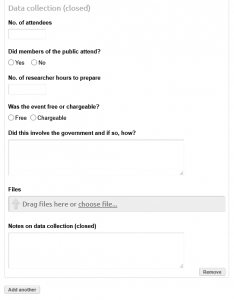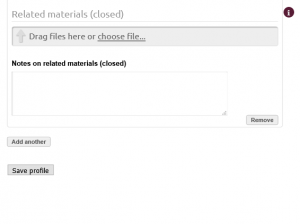The new Researcher Profiles feature a Public and community engagement (PCE) section which enables you to both record and share your engagement activities on your public-facing web page.
The PCE part of your Profile is split into two sub-sections:
1. Event or activity
 Here you can record the details of events / activities that are aimed at external stakeholders, meaning persons outside of academia or outside of your field of practice. Examples of such stake holders are the general public, industry professionals, policymakers, patient groups, etc.
Here you can record the details of events / activities that are aimed at external stakeholders, meaning persons outside of academia or outside of your field of practice. Examples of such stake holders are the general public, industry professionals, policymakers, patient groups, etc.
There is a range of types of activities already listed for selection in this sub-section (e.g. “Exhibitions”, “Screenings”, “Workshops” etc.), but also an “Other” category which can be used to record activities such as providing expert advice on the development of a piece of work / policy, for instance, through a stakeholder’s direct contact with you, or a policy consultation submission, rather than a public-facing event.
You can also link the event/activity to a specific output stored on the VRE.
2. Press/media:
 Here you can record and upload URLs for the following types of press engagement:
Here you can record and upload URLs for the following types of press engagement:
- Media appearance – press/media coverage in which you discuss your research, or which covers an event/activity you took part in, for instance;
- Media article – a piece in a non-academic publication that you have authored yourself;
- Expert comment – pieces that feature your expert commentary on a matter;
- Other – anything not covered by the above, e.g. a press/media piece that cites your work but that you were not directly involved in the writing / creation of.
Significantly, the PCE section also allows you to store private documentation for impact and reporting purposes.
In both the “Event or activity” and “Press/media” sub-sections there is a “closed” section for the recording of data that will not be visible to the readers of your profile page on the University of Westminster website.
Regarding the “closed” part of the “Event or activity” sub-section
Recording the number and nature of your attendees in this “closed” part is useful for reporting purposes; it will help us to determine the kind of broader institutional activity (REF, KEF, HE-BCI, etc.) your engagement work may align with.
 You can also upload and store files important for recording and tracking the impact of your activity. Such files may include, for instance:
You can also upload and store files important for recording and tracking the impact of your activity. Such files may include, for instance:
- your scanned / screenshot participant feedback surveys;
- correspondence from hosts / collaborators / attendees that may provide context or indications of the impact of your activity;
- the activity materials that were used (your powerpoint / handouts);
- and media (audio/video recording of the event).
In this “closed” parts you are also able to write notes on the collected data and how the activity fits in with your broader impact strategy, for instance:
- context such as your aims for the event (i.e. what benefit you intended to create for your stakeholders, whether you aimed to build capacity here for a future impact);
- whether this event built on a previous activity;
- recording the names and contact details of key contacts made through the event / activity;
- which media outlets covered the event (for cross-referencing with the sub-section below);
- challenges faced;
- how you intend to proceed and build on this event.
Such data is useful for both evidencing and developing your impact-related activities across this REF period.
Regarding the “closed” part of the “Press/media” sub-section
 You can upload and store “related materials” here useful for recording potential impact from the engagement, which may include, for instance:
You can upload and store “related materials” here useful for recording potential impact from the engagement, which may include, for instance:
- screenshots of analytics where available (number of reads / views / listens; you can update this across time if you come to be aware of ongoing interest in the piece);
- screenshots or a document collating comments from the audience of the piece that indicate impact or strong engagement with the piece by the audience;
- correspondence with the journalist / producer that may provide context or indications of the impact of your activity, etc.
The notes section can be used, for instance, to:
- record the contact details of the journalist / producer that contacted you (this may be useful for developing further relationships, e.g. pitching new research findings that may be of interest to them, or to follow up for an impact testimony if you had a significant role in aiding their practice);
- provide URLs to other articles that responded to the one you were involved in (note that it’s worth storing PDFs of these also);
- and general context on how the piece related to your research (e.g. if related to a specific output, mention it here).
A video guide on using this Public and Community Engagement section of the Researcher Profile is available on the RKEO YouTube channel here.
- Introducing the WestminsterResearch Profiles - August 23, 2022
- Researcher profiles: What’s new? Public and community engagement - June 17, 2021
- Obtaining Evidence for your Impact Case Studies - May 11, 2020

Pingback:Research Office » What is Open Research?